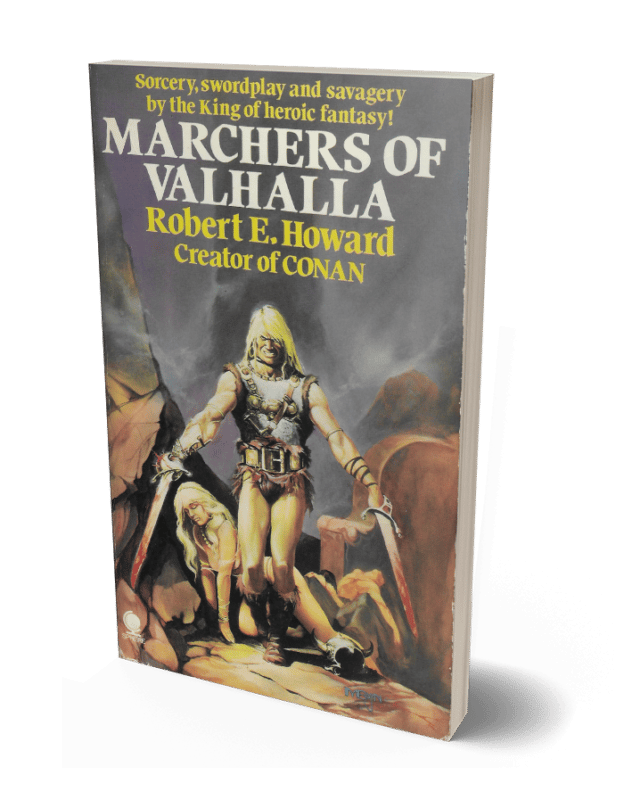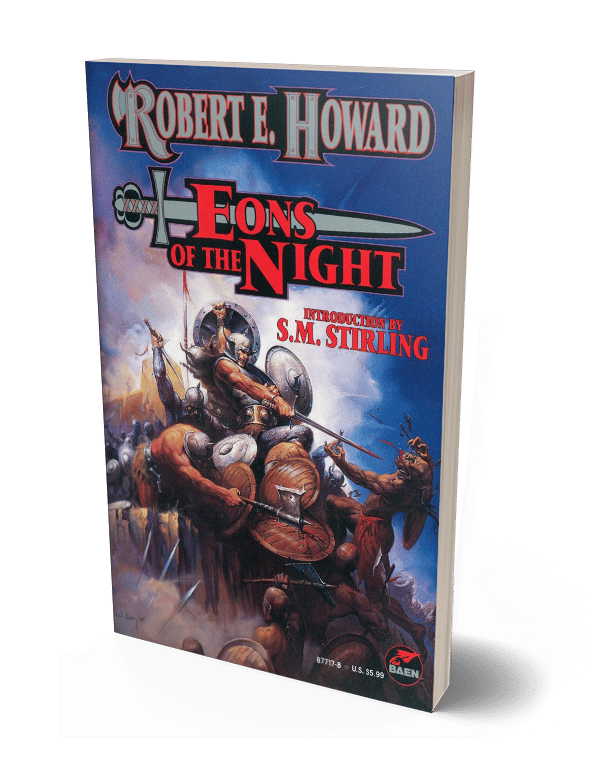Introduction
Features Turlogh Dubh O’Brien, “once a chief of Clan na O’Brien”.
“Spears of Clontarf” was rejected by SOLDIERS OF FORTUNE and Howard rewrote the story, adding more of a weird atmosphere. It was more than just changing a name here and there, he actually rewrote the story, giving it a new title, “The Grey God Passes.” Under this title, it was rejected by WEIRD TALES. In hopes of salvaging *something* from the whole affair, REH wrote an entirely new, contemporary horror tale titled “The Cairn on the Headland” which was based on some of the same elements. Baen published “The Grey God Passes” under its working title, “The Twilight of the Grey Gods”.
The manuscript and rejection letter for THE GREY GOD PASSES was sold on auction at HA.com on February 21, 2006, for $7,767.50. As of August 10, 2022, it is for sale at John W. Knott, Jr. Bookseller. The price is $22,500.00. The manuscript itself is 36 pages long and contains editorial marks and occasional notes. The rejection letter it got from Weird Tales magazine. The rejection letter states in part, “I am sorry to return your story, THE GREY GOD PASSES. The story itself, the plot, seems very slight, and the weird element is not as strong as I would like it to be.”
In a letter of provenance from Glenn Lord he states “Originally written as a straight historical entitled SPEARS OF CLONTARF the story was submitted to Clayton Magazines on June 1, 1930…” Rejected by Clayton, Howard re-wrote the story into its present form and submitted it to Farnsworth Wright at Weird Tales who rejected it in December of 1931. (This rejection letter accompanies the manuscript). It stayed in Howard’s files until after his death when August Derleth purchased the rights from literary agent Oscar J. Friend. He published the story in the anthology DARK MIND, DARK HEART (1962). The story occurs during the historical Battle of Clontarf which took place in the early 11th Century involving Brian Boru, High King of Ireland against the Vikings. Howard’s main characters are Turlogh Dubh O’Brien and an ex-slave named Conn. “The core of the story, as indicated by the title, is the end of the influence of supernatural beings from our world with the victory of Christian King Brian over the heathen Vikings. Among the Irish dead is a fey prince whose own death will cause the death of his fairy lover, a metaphor for the waning away of all the Sidhe. Odin himself makes an impressive and doomful appearance, making the battle a Götterdämmerung.
Rejection letter from Farnsworth Wright, December 28, 1928Alternate titles:
THE TWILIGHT OF THE GREY GODS
THE SPEARS OF CLONTARF (a non-fantastic version)
Howard’s first version (as Spears of Clontarf) finally saw print in a chapbook in 1978, and his Grey God Passes version was also published posthumously in the anthology collection titled Dark Mind, Dark Heart in 1962.
The story
“The Grey God Passes” is a vivid tale set during a tumultuous period in Irish history, focusing on the Battle of Clontarf and the symbolic end of the Norse gods’ influence over the region.
The story begins with Conn, a thrall (slave), confronting a mysterious stranger who knows of Conn’s killing of his master, Wolfgar Snorri’s son. The stranger, later revealed to be Odin, the Grey God, hints at an impending war in Ireland and vanishes after predicting doom and the fall of gods.
Meanwhile, various characters are introduced, each playing a pivotal role in the narrative. Dunlang O’Hartigan is a young chief, and Murrogh, son of King Brian Boru, is a prominent figure in the battle against the Norse invaders. King Brian Boru himself is portrayed as a wise and venerable leader, grappling with the responsibility of defending his kingdom.
The story intricately weaves the movements and strategies of various factions. The Norse invaders, led by figures like Jarl Sigurd and Brodir, are shown as fierce and formidable. On the Irish side, various clans and leaders, including Malachi O’Neill, King of Meath, and his nephew O’Kelly, add complexity to the narrative. The role of Kormlada (or Gormlaith), a queen with shifting alliances and manipulative intentions, is particularly intriguing.
The climax of the story is the brutal and chaotic Battle of Clontarf. Conn, fighting for his freedom and redemption, participates valiantly. The battle sees the death of many, including Murrogh and Dunlang. King Brian, despite his age and wisdom, meets a tragic end at the hands of Brodir, reflecting the harsh realities of war and the end of an era.
Odin’s presence looms throughout the story, symbolizing the fading influence of the Norse gods. His final disappearance into the northern mists marks the end of an epoch and the dawn of a new era in Ireland.
Characters
- Conn the Thrall: A tall, powerfully built slave of wild appearance. He plays a central role in the story, particularly in the Battle of Clontarf.
- Wolfgar Snorri’s son: Conn’s master, a Norseman on Torka.
- Odin/Mysterious Stranger: A tall man wrapped in a cloak, significant for his deep, powerful voice and one gleaming eye. He is symbolic and hints at a supernatural element. He is The Grey God, symbolizing the old Norse influence.
- King Brian Boru: The venerable Irish king, leading the Gaelic forces against the Norsemen. He is a key figure, embodying wisdom and leadership.
- Prince Murrogh: King Brian’s eldest son, a fierce warrior who plays a prominent role in the battle.
- Turlogh: Murrogh’s young son, who also participates in the battle.
- Turlogh Dubh O’Brien: A young warrior famed for his berserk rages and skill with an axe.
- Meathla O’Faelan: Prince of Desmond (South Munster), a key ally in the battle.
- Dunlang O’Hartigan: A young Gaelic chief, friend of Murrogh.
- O’Hyne: Chief of Connacht, part of the Gaelic forces.
- King Malachi (Melaghlin) O’Neill: The King of Meath, who hesitates to join the battle and is suspected of treachery.
- Eevin of Craglea: A member of the mystical De Danaans, Dunlang’s lover.
- Kormlada (Gormlaith): A queen involved in manipulating the Norse leaders, striving for power and control.
- King Sitric: The Viking King of Dublin, part of the Norse forces.
- Jarl Sigurd: A Norse leader with a significant role in the battle, known for his raven banner.
- Brodir of Man: A Viking leader, notorious for his savagery.
- Prince Amlaff: The son of the King of Norway, participating in the Norse invasion.
- Thorwald Raven: A Jarl of the Hebrides, Conn’s former master.
- Anrad the Berserk: A Viking warrior noted for his ferocity in battle.
- Various Norse and Gaelic warriors: They constitute the bulk of the forces in the battle, demonstrating the clash of cultures and fighting styles
Published in:
- DARK MIND, DARK HEART, Arkham House, 1962
- DARK MIND, DARK HEART, Mayflower, 1963
- DARK MIND, DARK HEART, Mayflower, 1966 (reissue)
- CONAN THE BARBARIAN #3, Marvel, February 1971
- FEH 5: DE STEM VAN EL-LIL, A. W. Bruna & Zoon, 1972 (Dutch)
- GIANT-SIZE CONAN #1, Marvel Comics, September 1974 (graphic adaptation)
- THE GREY GOD PASSES, Charles Miller, October 1975
- BEYOND MIDNIGHT, Berkley Medallion, November 1976
- ROBERT E. HOWARD OMNIBUS, Orbit, 1977
- MARCHERS OF VALHALLA, Grant 2nd. edition, 1977
- MARCHERS OF VALHALLA, Sphere, 1977
- MARCHERS OF VALHALLA, Berkley, January 1978
- CONAN THE BARBARIAN #1, PB, Marvel, 1978 (as a Conan story, “Twilight of the Grim Grey God”)
- TERRA FANTASY #50: GEISTER DER NACHT, Erich Pabel Verlag KG, August 1978 (German)
- TERRA FANTASY #50: GEISTER DER NACHT, Erich Pabel Verlag KG, March 1981 (German, 2nd printing)
- RACCONTI SENZA RESPIRO. VOLUME PRIMO, Arnoldo Mondadori Editore, June 1981 (Italian)
- BRAN MAK MORN, NeO, November 1982 (French)
- BLAGDAROSS 7, Blagdaross, 1982 (Spanish)
- BRAN MAK MORN, NeO, January 1985 (French, 2nd printing)
- CONAN SAGA VOLUME 1 NUMBER 1, Marvel Comics, May 1987 (graphic adaptation featuring Conan)
- WĘDROWCY Z VALHALLI, Wydawnictwo Andor, 1991 (Polish)
- BRAN MAK MORN, Fleuve Noir, February 1993 (French)
- KADOTUKSEN KUILU, WSOY, 1993 (Finnish)
- I SIGNORI DELLA SPADA, Newton Compton Editori, March 1994 (Italian)
- HARMAAN JUMALAN HETKI, WSOY, 1994 (Finnish)
- ZMIERZCH NAD STONEHENGE, Wydawnictwo GEA, 1994 (Polish)
- TUTTI I CICLI FANTASTICI – I CICLI CELTA E DI FACCIA DI TESCHIO, Newton Compton Editori, April 1995 (Italian)
- EONS OF THE NIGHT, Baen, March 1996 (restored text) (as “The Twilight of the Grey Gods”)
- LHORK 17 (ESPECIAL AVENTURAS Y EDGAR RICE BURROUGHS, Círculo de Lhork, 1997 (Spanish)
- THE NIGHT OF THE WOLF, North-West, 1997 (Russian)
- ダーク・ファンタジー・コレクション (DĀKU FANTAJĪ KOREKUSHON 5) DARK FANTASY COLLECTION 5 , RonsoSha, March 2007 (Japanese)
- CRIMSON SHADOWS: THE BEST OF ROBERT E. HOWARD VOLUME 1, Del Rey, August 2007
- CRIMSON SHADOWS: THE BEST OF ROBERT E. HOWARD VOLUME 1, Subterranean Press, November 2009
- LES DIEUX DE BAL-SAGOTH, Bragelonne, March 2010 (French)
- BAL-SAGOTHI JUMALAD, Fantaasia, March 2011 (Estonian)
- I SIGNORI DELLA SPADA, Newton Compton Editori, May 2012 (Italian)
- LES DIEUX DE BAL-SAGOTH. LE CRÉPUSCULE DU DIEU GRIS, Bragelonne, May 2013 (French)
- FEKETE TURLOGH ÉS A KELTÁK, Delta Vision Kft., November 2014 (Hungarian)
- SWORDS OF THE NORTH, REH Foundation Press, December 2014
- DIE KINDER DER NACHT, Festa Verlag, November 2015 (German)
- LOS DIOSES DE BAL-SAGOTH, Costas de Carcosa, February 2016 (Spanish)
- ODINS LETZTE SCHLACHT, Uksak E-Books, April 2016 (German)
- LES ROIS DE LA NUIT, Le Livre de Poche, November 2020 (French)
- IL CICLO CELTA, GM Libri, February 2021 (Italian)







